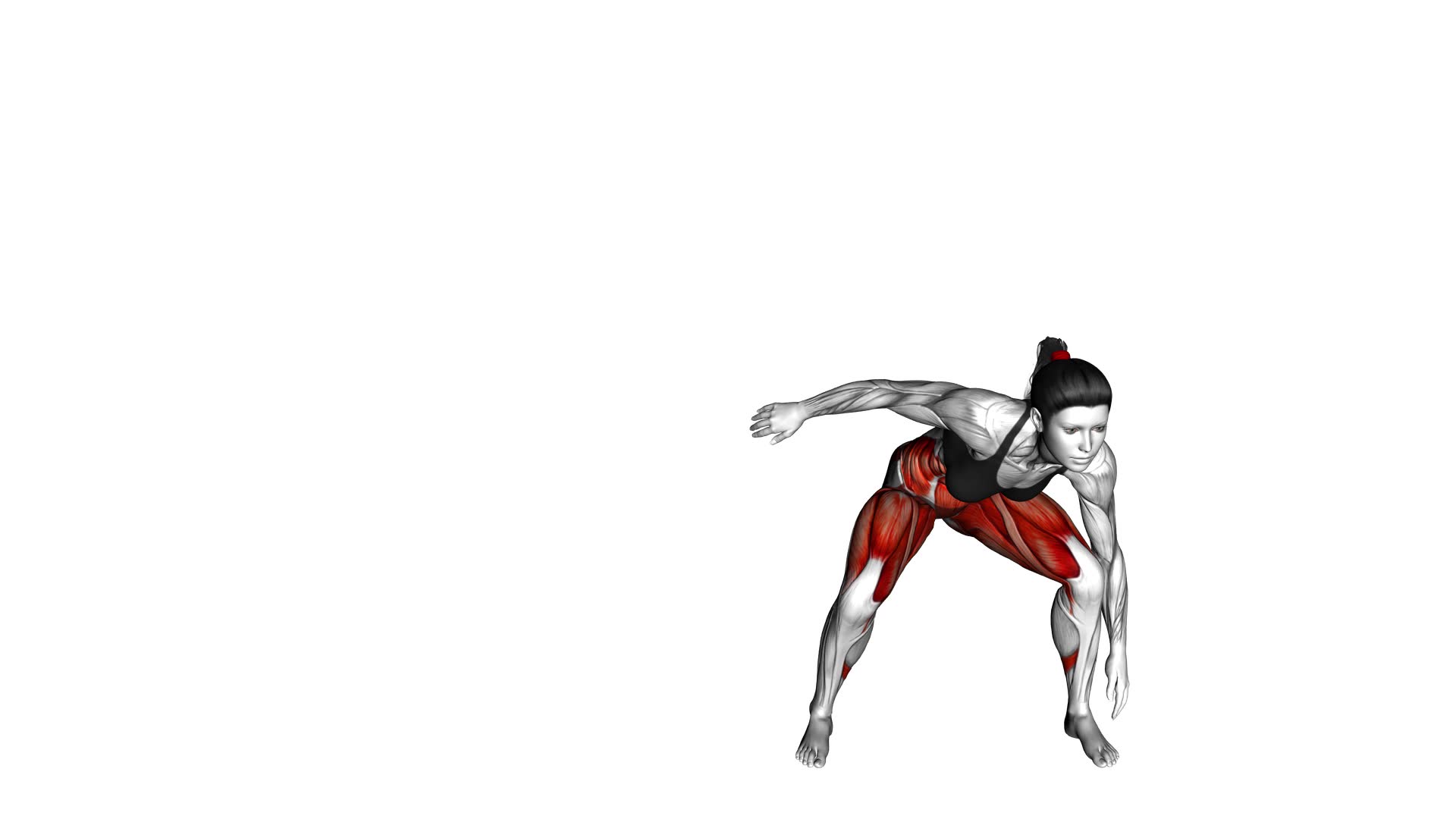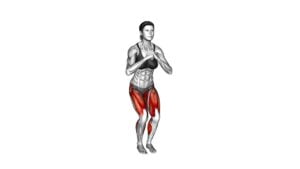Lateral Shuffle Squat Tap (female) – Video Exercise Guide & Tips

Are you looking for a challenging lower body exercise that targets your glutes, quads, and inner thighs? Look no further than the Lateral Shuffle Squat Tap!
Watch This Exercise Video
In this video exercise guide, we'll show you how to perform this move with proper form and technique. Whether you're a beginner or advanced fitness enthusiast, we've got modifications to suit your fitness level.
Avoid common mistakes and get tips on how to incorporate the Lateral Shuffle Squat Tap into your workout routine.
Let's get moving!
Key Takeaways
- The Lateral Shuffle Squat Tap is a beneficial exercise that improves agility, leg strength, and the ability to change direction quickly.
- This exercise targets the glutes, quads, and inner thighs, while also improving balance and coordination.
- Proper form and technique are important for maximum effectiveness, including maintaining a shoulder-width stance, proper knee alignment, and engaging the core.
- Modifications can be made for different fitness levels, such as reducing range of motion for beginners or adding resistance bands for advanced individuals.
Benefits of the Lateral Shuffle Squat Tap
You can experience several benefits from incorporating the lateral shuffle squat tap into your workout routine. This exercise is a great way to improve your agility and increase your leg strength. The lateral shuffle movement helps to enhance your ability to change direction quickly, which is crucial in sports and other physical activities.
By performing the squat tap at the end of the shuffle, you engage your leg muscles even more, leading to increased leg strength. This exercise targets your quadriceps, hamstrings, glutes, and calves, helping to tone and strengthen these muscles.
Additionally, the lateral shuffle squat tap can also improve your balance and coordination. As you move laterally, you have to maintain control and stability, which can enhance your overall body awareness and coordination.
By incorporating this exercise into your routine, you can enjoy improved agility and increased leg strength.
Now, let's move on to the next section and dive into the proper form and technique for performing the lateral shuffle squat tap.
Proper Form and Technique
To perform the lateral shuffle squat tap correctly, begin by standing with your feet shoulder-width apart and your knees slightly bent. This exercise is all about maintaining proper form and technique to maximize its effectiveness. One common misconception is that you need to rush through the movement. However, it's important to remember that quality beats quantity. Take your time and focus on each step to ensure you're engaging the correct muscles and maintaining stability.
As for variations, you can increase the difficulty by adding resistance bands around your ankles or holding dumbbells in your hands. These modifications will challenge your muscles even more and help you progress in your fitness journey. Another progression is to increase the speed of the lateral shuffle, making it a more dynamic and intense exercise.
Proper form is crucial to prevent injuries and get the most out of the lateral shuffle squat tap. Keep your core engaged, back straight, and chest lifted throughout the entire movement. As you shuffle to the side, make sure your knees are tracking over your toes and your weight is evenly distributed. When tapping the ground with your opposite hand, focus on maintaining balance and stability.
Modifications for Different Fitness Levels
How can the lateral shuffle squat tap be modified for different fitness levels?
This exercise can be modified to suit both beginners and those who are more advanced in their fitness journey.
For beginners, it's important to start with proper form and technique before attempting any modifications. One way to modify the lateral shuffle squat tap for beginners is by reducing the range of motion. Instead of squatting deeply, beginners can perform a shallow squat or even just a tap to the side. This will help build strength and stability before progressing to a deeper squat. Additionally, beginners can start with slower and smaller shuffles to ensure proper control and balance.
On the other hand, advanced individuals can challenge themselves with various modifications to increase the intensity of the exercise. One advanced variation is to add a resistance band around the thighs to increase the resistance and engage the muscles even more. Another option is to incorporate a jump or a plyometric movement during the shuffle to add an explosive element to the exercise. This won't only work the lower body but also improve cardiovascular endurance.
In conclusion, the lateral shuffle squat tap can be modified to accommodate different fitness levels. Beginners can start with reduced range of motion and slower shuffles, while advanced individuals can add resistance or plyometric movements. By modifying the exercise according to your fitness level, you can ensure a safe and effective workout.
Now let's move on to discussing common mistakes to avoid when performing this exercise.
Common Mistakes to Avoid
As you progress in your lateral shuffle squat tap, it's important to be aware of common mistakes to avoid. Maintaining proper technique is crucial for maximizing the effectiveness of this exercise and minimizing the risk of injury. Here are some common mistakes to watch out for:
- Collapsing knees: Make sure to keep your knees in line with your toes throughout the movement. Avoid letting them cave inwards, as this can strain your joints and lead to imbalances.
- Lack of depth: When performing the squat tap, aim to lower your body down into a deep squat position. Going only halfway will limit the engagement of your muscles and reduce the overall benefits of the exercise.
- Poor lateral movement: Focus on moving laterally with control and precision. Avoid rushing through the shuffle, as this can compromise your form and balance.
Tips for Incorporating the Lateral Shuffle Squat Tap Into Your Workout Routine
To incorporate the lateral shuffle squat tap into your workout routine, focus on maintaining proper form and gradually increasing the intensity and duration of the exercise. This exercise targets multiple muscle groups, including the glutes, quads, and inner thighs, while also improving your cardiovascular endurance.
If you're an advanced athlete looking for more challenge, there are variations you can try. One option is to add resistance by holding a dumbbell or kettlebell at chest level while performing the lateral shuffle squat tap. Another variation is to increase the speed and explosiveness of your movements, making the exercise more dynamic and engaging.
Additionally, you can incorporate the lateral shuffle squat tap into circuit training sessions. Circuit training involves performing a series of exercises with little to no rest in between. By including the lateral shuffle squat tap in your circuit, you can elevate your heart rate, burn more calories, and improve your overall strength and endurance.
Remember to warm up before starting any exercise and cool down afterwards to prevent injury and promote recovery. As you progress, gradually increase the number of sets and repetitions or the amount of time you spend performing the exercise. Listen to your body and make adjustments as needed.
With consistency and proper technique, the lateral shuffle squat tap can be a valuable addition to your workout routine.
Frequently Asked Questions
How Many Calories Can You Burn by Doing the Lateral Shuffle Squat Tap?
You can burn a significant amount of calories by doing the lateral shuffle squat tap. This exercise is highly effective for weight loss as it engages multiple muscle groups and increases your heart rate.
It combines lateral movements, squats, and taps to challenge your body and boost calorie burn. Additionally, the lateral shuffle squat tap can be modified to suit different fitness levels.
Beginners can start with slower movements and fewer reps, while advanced individuals can increase intensity and add weights for an extra challenge.
Can the Lateral Shuffle Squat Tap Help Improve Balance and Coordination?
The lateral shuffle squat tap is a great exercise for improving balance and coordination. By incorporating lateral movements and squats, this exercise challenges your body to maintain stability and control.
It also helps to develop agility, as you move quickly from side to side. Additionally, there are variations of the lateral shuffle squat tap that can further enhance your balance and coordination, such as adding a resistance band or performing it on an unstable surface.
Is It Necessary to Use Weights While Performing the Lateral Shuffle Squat Tap?
Using weights for the lateral shuffle squat tap isn't necessary, but it can add an extra challenge to your workout. If you're new to this exercise or prefer not to use weights, you can still benefit from it by focusing on maintaining proper form and increasing your speed.
However, if you want to increase the intensity, you can use dumbbells or resistance bands. Remember to start with lighter weights and gradually increase as you become more comfortable.
How Often Should the Lateral Shuffle Squat Tap Be Included in a Workout Routine?
The frequency of including the lateral shuffle squat tap in your workout routine depends on your fitness goals and overall fitness level. It's recommended to start with 2-3 times per week and gradually increase as you get stronger and more comfortable with the exercise.
Remember to listen to your body and take rest days as needed.
Additionally, there are variations and modifications of the lateral shuffle squat tap that you can incorporate to add variety and challenge to your workouts.
Can the Lateral Shuffle Squat Tap Be Beneficial for Individuals With Knee or Hip Problems?
The lateral shuffle squat tap can be a beneficial exercise for individuals with knee or hip problems. It helps to strengthen the muscles around these joints, improving stability and reducing the risk of injury.
However, if you have knee or hip issues, it's important to listen to your body and modify the exercise as needed. Consider alternatives like side lunges or lateral step-ups, and make sure to consult with a healthcare professional for personalized guidance.
Conclusion
Incorporating the lateral shuffle squat tap into your workout routine can provide numerous benefits. This exercise targets multiple muscle groups, improves agility and coordination, and boosts cardiovascular endurance. By following proper form and technique, you can maximize the effectiveness of this exercise.
Remember to modify the intensity based on your fitness level and avoid common mistakes such as collapsing the knees or rounding the back.
Add the lateral shuffle squat tap to your routine for a challenging and rewarding workout.

Author
Years ago, the spark of my life’s passion ignited in my mind the moment I stepped into the local gym for the first time. The inaugural bead of perspiration, the initial endeavor, the very first surge of endorphins, and a sense of pride that washed over me post-workout marked the beginning of my deep-seated interest in strength sports, fitness, and sports nutrition. This very curiosity blossomed rapidly into a profound fascination, propelling me to earn a Master’s degree in Physical Education from the Academy of Physical Education in Krakow, followed by a Sports Manager diploma from the Jagiellonian University. My journey of growth led me to gain more specialized qualifications, such as being a certified personal trainer with a focus on sports dietetics, a lifeguard, and an instructor for wellness and corrective gymnastics. Theoretical knowledge paired seamlessly with practical experience, reinforcing my belief that the transformation of individuals under my guidance was also a reflection of my personal growth. This belief holds true even today. Each day, I strive to push the boundaries and explore new realms. These realms gently elevate me to greater heights. The unique combination of passion for my field and the continuous quest for growth fuels my drive to break new ground.







